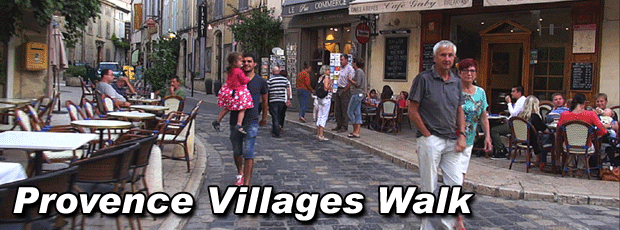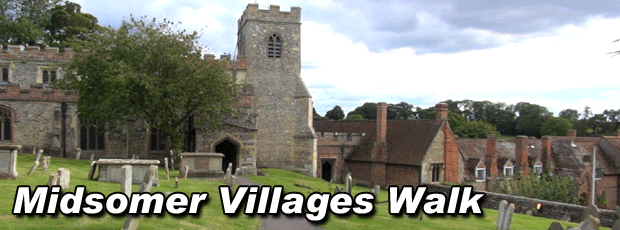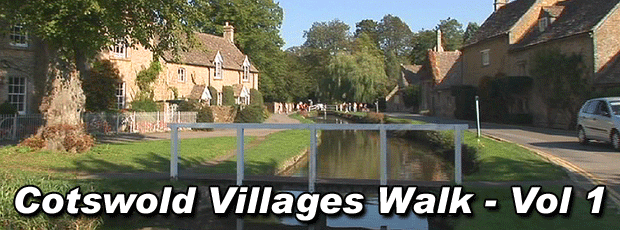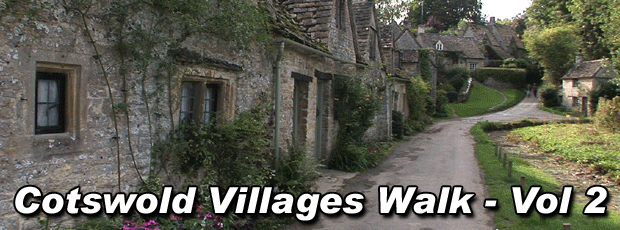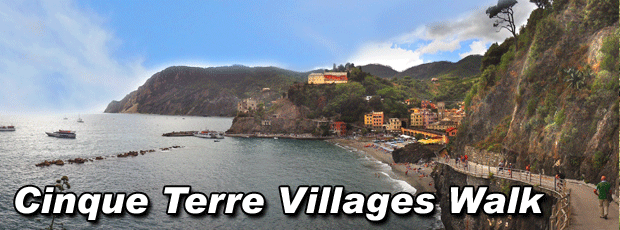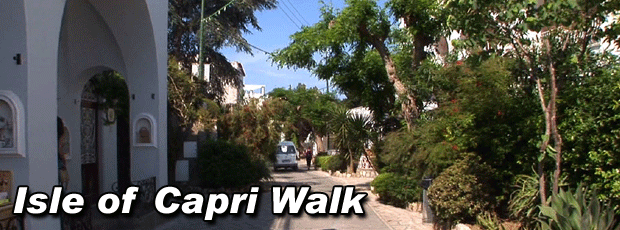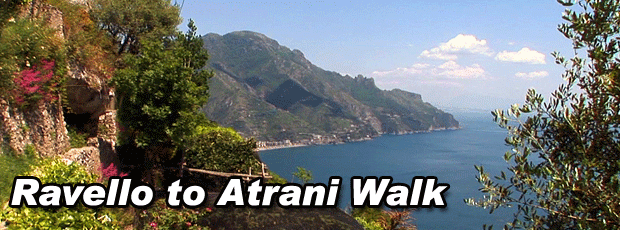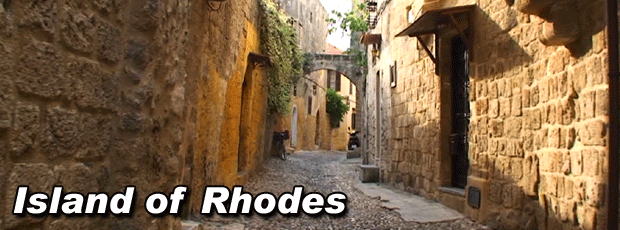-
You'll visit the Provence villages of Viens, Lourmarin, Saignon, Lacoste, Ansouis, and Menerbes - 3 of these villages have been designated, "L'un Des Plus Beaux Villages de France" by the French.
Click on photo at left to watch clips from this video. DVD $14.99 - Download $6.99
-
A 60 minute walk through seven quaint Oxfordshire villages so beautiful that they were used as filming locations for the hit BBC TV Series, "Midsomer Murders."
Click on photo at left to watch clips from this video. DVD $14.99 - Download $6.99
-
Your 60 minute walk through four quaint Cotswold villages: Chipping Campden, Broadway, Upper Slaughter, and ends in Lower Slaughter, arguably one of the most beautiful villages in the Cotwolds.
Click on photo at left to watch clips from this video. DVD $14.99 - Download $6.99
-
A 60 minute walk through 5 more picturesque Cotswold English villages: Snowshill, Stanton, Bourton-on-the-Water, Bibury, and ends in arguably the single most scenic village in all of the Cotswolds, Castle Combe.
Click on photo at left to watch clips from this video. DVD $14.99 - Download $6.99
-
Take a 60 minute virtual walk in the five timeless villages that make up Italy's Cinque Terre, a UNESCO World Heritage site, and made famous by PBS Travel Guru Rick Steves.
Click on photo at left to watch clips from this video. DVD $14.99 - Download $6.99
-
This 50 minute Virtual Walk begins in the picturesque town of Anacapri, set atop the famous island. Further on, the path narrows and begins to hug the side of the cliff, with the blue Mediterranean Sea stretching out below you.
Click on photo at left to watch clips from this video. DVD $14.99 - Download $6.99
-
Take a 51 minute breathtaking Virtual Walk on your treadmill from Italy's village of Ravello down to the town of Atrani on the Amalfi Coast and through some of the most beautiful scenery ever!
Click on photo at left to watch clips from this video. DVD $14.99 - Download $6.99
-
This 60 minute Virtual Walk takes you on a tour through the city of Old Town on the Greek Island of Rhodes.
Click on photo at left to watch clips from this video. DVD $14.99 - Download $6.99
Your treadmill can transport you to quaint, picturesque villages in Provence, France, or the Midsomer Villages used in the hit BBC TV Series, "Midsomer Murders," or to England's charming Cotswold Villages, or Italy's famous Cinque Terre Villages, or exlusive village of Ravello, or to the beautiful Mediterranean Islands of Rhodes and Capri!
If you love charming scenic villages, their beauty, and scenery, then you'll love taking one of our virtual walks through different quaint villages around the world, such as:
PROVENCE:
Your 60 minute Provence Villages Virtual Walk begins overlooking a valley outside the hilltop village of Viens. You turn and approach the village proper and enter the village of Viens through a courtyard and find yourself walking in a beautiful narrow French street which winds its way between timeless stone houses that have been homes to countless families through the centuries. You turn and walk through a stone archway and, after walking through a second stone archway you pause to take in another stunning view of the landscape that is Provence. But Viens has even more memorable scenes to offer, just waiting to be captured on canvas.
Next, you enter the village of Lourmarin, designated "L'un Des Plus Beaux Villages de France" by the French. And you can see why the village was so honored, Lourmarin is a typical Provence village, with its sidewalk cafes with families enjoying the warm September afternoon and friendly, welcoming faces. Lourmarin has wide, tree lined streets and narrow streets with shops and cafes just waiting to be explored. Lourmarin typifies the relaxed, romantic, Mediterranean style of life with hand-in-hand strolls or sitting leisurely at an outdoor cafe with a glass of wine, lemonade, or favorite aperitif. Your Provence Villages Virtual Walk next takes you to the hilltop village of Saignon. The church you see in the distance, the 12th century Saint Mary of Saignon, has been a stopping point for religious pilgrims since the Middle Ages.
Once again beginning your walk from a hilltop outside the village proper, as you turn and begin your descent, you pause to admire the magnificent view, then you proceed through an archway and over more winding, narrow walkways and through a small courtyard with a centuries old fountain on the outside of the 12th century village church where Marriage Banns are still posted. Then on to the village of Lacoste, a village where time appears to be standing still. Lacoste is best known for its most notorious resident, the Marquis de Sade, who in the 18th century lived in Château de Lacoste. Today, fashion designer Pierre Cardin has purchased the Château and built a new residence within its ruined walls.
You descend from the Château walking around the perimeter and cross the bottom of the dry moat and once again, pause for a view of the valley and the incredible Provencal landscape. Then you continue down through the nearly empty stone streets of Lacoste where, today the Savannah College of Art and Design has classes here for art students and professors from all corners of the globe studying fine arts, writing, architecture, design, fashion, film, photography, sculpture, and theater. During World War II, the French Resistance took their foothold in the steep Luberon Mountains around Lacoste and trenches and barbed wire still can be found in the forested area in the valley. Next you visit Ansouis, also designated "L'un Des Plus Beaux Villages de France" by the French.
Ansouis, often described as a 'mini version' of nearby Gordes, is a quaint medieval village dating to the 10th century. Ansouis is one of the less well known of the Provence villages, but the day we filmed, it had a few tourists and a dog or two while other sections of Ansouis were compeletely empty. The last village you will visit on the one hour video is Menerbes, also designated "L'un Des Plus Beaux Villages de France." Ménerbes became known in the English-speaking world through the books of British author Peter Mayle who related his experiences as a British expatriate who settled in this village. You will walk through the village and up to its summit to take in a spectacular view of the hilltop village and surrounding countryside before continuing on through Menerbes. Your 60 minute Village Virtual Walk continues through the village and ends with a spectacular view of the Provence countryside.
MIDSOMER:
Your 60 minute Village Virtual Walk begins beside the river in the village of Henley-on-Thames. The walk beside the Thames is crowded with people enjoying a sunny August day. Ahead is the Henley Bridge with its five elliptical stone arches, built in 1786. The current bridge replaced an earlier wooden structure, the foundations of which can be seen in the basement of the Henley Royal Regatta headquarters nearby on the Berkshire side. However, the remains of two stone arches on both sides of the river indicate the existence of an even more ancient stone bridge prior to the timber structure.
This bridge has been identified by some authors as the bridge which the Romans crossed pursuing the Britons in 43AD, as described by Dion Cassius. Turning left we cross the street, walk past St. Mary's Church and walk through the village center. Next you enter the village of Dorchester-on-Thames and first pass Dorchester Abbey, then turning onto High Street you pass the George Hotel, one of Britain's oldest coach inns, which dates back to the 15th century and has appeared in many Midsomer Murder episodes. Walking further down High Street, we come to the village's War Memorial. You next enter Warborough and begin your village walk in the grounds of the parish church of St. Laurence, then turn into the village center, walk past numerous cottages and cross the village's cricket field. After crossing the cricket field, we pass by the Six Bells, a beautiful English Pub dating from the 1600's in the heart of the village, which I'm sure you'll recognize from its numerous appearances in the TV series.
Next we enter Ewelme, and through the grounds of the 15th-century parish church of St. Mary the Virgin. This quiet village is the perfect place to rest by a small pond and watch the ducks play. Then it's on to Watlington, a market town in the Chiltern Hills with several half-timbered structures. Many 16th- and 17th-century cottages and houses survive today in Watlington and some have been little altered. Of course, the village has its War Memorial proudly displayed, one of about 100 free-standing war memorials in Oxfordshire. Then on to the small village of Lewknor and through the grounds of St. Margaret's parish church where you turn right and follow High Street, where many of the cottages in Lewknor are built using flints. It's appropriate that you saved Wallingford for our last village to tour. Wallingford has a strong history in the fictional murder mystery genre.
Agatha Christie, who is buried at nearby Cholsey, lived and worked in Wallingford and Wallingford is the filming location of the fictional village of Causton in the TV series "Midsomer Murders." Turning right onto High Street, we pass another 16th-century coaching inn, The George Hotel and, after crossing another bridge, your one-hour Midsomer Villages Virtual Walk ends, where it started 60 minutes ago, beside the River Thames.
COTSWOLDS:
The first volume of your 60 minute Cotswold Villages Virtual Walk begins beside the historic St. James Church in the village of Chipping Campden, a small market town in the Cotswold district of Gloucestershire. Passing the Alms House you follow Church Street until it intersects with High Street and once on High Street, you encounter and pass through the famous Market Hall, built in 1627 by Sir Baptist Hicks, a prosperous Wool Merchant of that period. Leaving Market Hall, you pause for a brief look at the typical honey-coloured limestone buildings typical of the Cotswolds, then on down the street and eventually out of the center of Chipping Campden. On the outskirts of Chipping Campden, you pause to admire "Little Orchard," the home of Graham Greene, the prolific English novelist, playwright, short story writer, and critic and his wife Vivien between 1931 and 1933.
Then following the Cotswold Way, a 102-mile footpath and designated National Trail since 2007, you enter the east end of the village of Broadway by passing through a sheep field. Broadway has a wide main street lined with red chestnut trees and honey-coloured Cotswold limestone buildings, many dating from the 16th century. Often referred to as the "Jewel of the Cotswolds," Broadway is a center for arts and antiques and has a unique character all its own with tea rooms, hotels and pubs, all clustered near the expansive village green.
Then it's on to the small village of Upper Slaughter on a footpath beside the River Eye. Upper Slaughter was identified by author Arthur Mee as one of 32 "Thankful Villages." In Enchanted Land (1936), he wrote "that a Thankful Village was one which had lost no men in the Great War because all those who left to serve came home again." Although the village was subject to an air raid, it also lost no men in World War II, an honor held by only 14 villages, known as the "Doubly Thankful Villages." Climbing the hill and turning to the right, you encounter a sign reading "Flowers in Church." St. Peter's is the quintessential country church complete with working bells and polished pews. The church was renovated in 1877. During that renovation, much of the original fabric was re-used, and the original plan of the medieval church was not greatly altered. St. Peter's is lovingly decorated by local parishioners using flowers grown in their gardens, and after taking time to admire the "Flowers in Church," you move on to the nearby village of Lower Slaughter, entering by walking on a small path beside the River Eye.
As in Upper Slaughter, the village of Lower Slaughter is situated on both banks of the River Eye. Records exist showing that Lower Slaughter has been inhabited for over 1000 years and where most of the 16th and 17th century homes in the village use Cotswold sandstone and are adorned with mullioned windows and often with other embellishments such as projecting gables. You pause to enjoy the profusion of blooming flowers in almost every yard and then cross a stone footbridge and turn left and pause again to view a 19th-century water mill with an undershot waterwheel and a chimney for additional steam power. Behind the water mill, you turn onto a small path and pass through a gate which commemorates a visit by Prince Charles and Lady Diana in 1981. You continue walking northwest out of the village, beside the now wider river where your one hour Cotswold Villages Virtual Walk - Volume 1 ends here beside the River Eye.
The second volume of your 60 minute Cotswold Villages Virtual Walk begins outside of the charming village of Snowshill. Walking down the hill and past some typical honey-colored cottages, constructed of local limestone, you eventually reach the center of Snowshill and pause for a moment beside the Church of St. Barnabus and its old graveyard with so many stories to tell. Your walk through Snowshill pauses periodically to contemplate the various quaint cottages found here before leaving the village by way of a tree-lined road you continue on as you next enter the village of Stanton.
Walking behind an elderly gentleman out for a stroll, you stop to take in a lovely thatched-roofed cottage on the outskirts of Stanton. Further on, a group of riders pass as you enter into the center of this traditional Cotswold village. Everywhere you look, green plants are thriving. Following the "Cotswold Way" road post, you leave Stanton and next enter into the picturesque village of Bourton-on-the-Water. The River Windrush flows through the heart of this popular Cotswold village. Your walk follows the footpath beside the river as it cuts through the village.
The idyllic village of Bibury is next on your walk. Starting at the Church, you soon pause at the famous Arlington Row, certainly one of the most well-known and most photographed sites in the Cotswolds. Further on, your walk takes you beside Rack Isle, where dyed woolens were once hung to dry, and on through the village and past the historic Swan Hotel. And last, your hour-long walk takes you into arguably the most scenic village in all of the Cotswolds, Castle Combe. You follow a narrow forest footpath, and suddenly the village appears - as if by magic. This quintessential old English Village has been the setting of numerous TV programs including an Agatha Christie's Hercule Poirot mystery along with the children's motion picture, Dr. Dolittle. Your walk will actually take you inside this quiet and tranquil church to view the effigy of a knight in a suit of chain mail who has rested here for centuries.
Steven Spielberg's production of "War Horse," nominated for 6 Oscars, along with the motion pictures Stardust and The Wolfman were filmed in this picture-postcard English Village along with the 1999 Neil Gaiman movie, "Stardust." After a complete walking tour of this picturesque village, your 60 minute walk ends at the By Brook.
CINQUE TERRE:
Made famous by world traveler Rick Steves, Cinque Terre ("Five Lands") are five beautiful Italian Rivera hillside villages. Your 60 minute Cinque Terre Virtual Villages Walk begins high on a cliff walkway directly south of the small village of Riomaggiore, the first of the five villages that define the Cinque Terre. After you descend the stone stairs, you turn to see the families enjoying a delightful September afternoon, then turn northward towards the village which is nestled in a narrow valley.
Fishermen store their boats the only place they can - in the narrow street that runs through the center of Riomaggiore. After climbing stairs we enter Via Colombo, Riomaggiore's beautiful primary street and it's an uphill climb but quite scenic as your path first gets narrower then widens as you pass the Church of San Giovanni Battista of Riomaggiore. Now you are high above the sea but still in the village of Riomaggiore and you pass an amazing mural painted on the side of steps before continuing on through more typical Italian scenery. As you leave Riomaggorie, you look northward towards the next Cinque Terre village Manarola.
This time, for ease of filming, you're walking southward to enter the village. Following the steeply terraced vineyard path which winds around the side of the mountain, you get excellent views of Manarola - but watch your step, the walkway is treacherous. This is a popular path with the serious hikers and your path curves eastward, towards the main entrance to the village. Your path approaches, then passes the Church of Nativity of the Virgin Mary which dates back to 1338. Manarola is the second smallest of the famous Cinque Terre towns. The closer to the waterfront we get, the more crowded with tourists Manarola becomes.
Manarola's primary industries have traditionally been fishing and wine-making, but today tourism is number one in the summer months. Before moving on to the next village, you pause to admire the busy harbor. Your walk in Corniglia, the third of the five villages, begins at a terrace overlooking the sea. Unlike the other villages, Corniglia is not directly next to the sea, but located about 100 meters above it and even from the terrace overlook, it's still mostly uphill through some attractive streets and alleyways, then up some stairs and turn the corner through more narrow walkways and you find yourself walking in more steeply terraced vineyards.
This segment of your walk ends with a view down to Corniglia's train station, but in order to reach it, hikers have a choice of 383 steps down or a 3 mile winding road. Your first view of Vernazza, the fourth of the five villages, which remains one of the true "fishing villages" on the Italian Riviera is reached after following another winding mountainside trail and you enter Vernazza through a narrow alleyway. Today, as you would expect, the main source of revenue for Vernazza is tourism however, fishing, wine and olive oil production still continue to be an important source of income for the village. On 25 October 2011, Vernazza was struck by torrential rains, massive flooding, and mudslides that left the town buried in over 4 metres of mud and debris, causing over 100 million euro worth of damage. Fortunately, the destruction to the hillside village has been repaired.
Monterosso al Mare, the fifth and final village that makes up the Cinque Terre, lies ahead. Actually, "Old Town" is ahead while "New Town" lies hidden behind a rocky promontory. One of the easiest and most scenic sections of your walk lies ahead - and it's almost all downhill. As we enter "Old Town," the walkway gets wider. and a train rushes by. One of two ways to get to "New Town" is up a steep walkway that takes you around the rocky promontory, then it's downhill with the "New Town" in the distance. Monterosso al Mare possesses the only extensive sandy beach in the Cinque Terre. The largest by far of the five villages, Monterosso al Mare actually has a street wide enough for cars and certainly has some beautiful scenery. After walking through Monterosso al Mare's "Old Town" and "New Town," your one hour Cinque Terre Villages Virtual Walk ends on the beach.
ISLE OF CAPRI:
Beginning in the picturesque town of Anacapri, set atop the Isle of Capri, you'll walk along a small street lined with shops and intimate sidewalk cafes. Passing more shops and sidewalk cafes, you enter an area reached by few tourists and pass into a piazza and pass Santa Sofia, the main church of Anacapri.
You are in the residential section of Anacapri, where the locals reside in the midst of charming homes and streets - sun-washed white walls, Bougainvillea in bloom, winding pathways and a solitude and tranquility that is rare in today's world. From time to time, you do have to share the narrow street with motor scooters and small cars.
Now, your pathway hugs the side of the island, with the blue Mediterranean Sea below and some of the most spectacular scenery awaits you along the pathway ahead. Entering and passing through a small green forest, you discover an ancient turreted tower guarding the cliff and the remains of the summer home of Roman Emperor Tiberius.
RAVELLO:
The first part of your 51 minute walk begins in Ravello's Piazza del Duomo, which features a thirteenth century campanile. After crossing the piazza, and dodging a young Italian on a scooter, a little terrier is waiting to guide you on the first part of your walk. Your four-legged tour guide obviously knows his way around Ravello and is used to bounding up the stone steps. As the terrier runs ahead, you continue up the seemingly endless steps, passing residents and hikers as they stop to admire the villas along the way.
The village of Ravello dates back to the ninth century and was once called Rebellum since it rebelled against its larger rival, Amalfi. The Ravello to Atrani walk offers the chance to admire architectural elements warmed by the Mediterranean sunshine. The village of Ravello is located in the province of Salerno, in the region of Italy known as Campania. The stone steps and pathways no doubt made commerce and communication easier as far back as the Middle Ages. And from time to time along the trail, you pass through thickets of olive trees, freesias and cistus in the springtime.
The wild flowers you will pass along this ancient pathway are surprisingly varied: white heather, spurge, squill, mint, and valerian - to name but a few. Every part of this walk offers a chance to commune with nature in one of the most breathtaking regions of Italy, the Amalfi Coast, with its sun-washed stone walls, cats resting in the shade, and a solitude and tranquility so rare in today's world.
The village of Ravello - as all communities along la Costiera Amalfitana - face towards the Tyhrrenian Sea and below lies the town of Atrani with its campanile where so much beauty awaits in Atrani that photographers love it. Fortunately, this serene little town is also overlooked by the hoards of tourists who are just a few miles away in nearby Amalfi. To reach Atrani from Ravello, you must descend countless steps on your journey but pause, from time to time, to enjoy the spectacular views. Entering Atrani, you pause for a moment at a shrine to Italy's beloved Padre Pio before continuing on deeper into enchanting Atrani. You enter into Piazza Umberto with its welcoming fountain and outdoor cafe. Your walk ends at a peaceful sandy beach - you have descended 1200 feet in 51 minutes and have memories destined to remain with you for years.
ISLAND OF RHODES:
Your 60 minute Virtual Walk begins beside the Kolona Harbour on the island Rhodes, once the site of the Colossus of Rhodes, a statue of the Greek titan-god of the sun Helios, erected in the city of Rhodes, on the Greek island of the same name, by Chares of Lindos in 280 BC. One of the Seven Wonders of the Ancient World, it was constructed to celebrate Rhodes' victory over the ruler of Cyprus, Antigonus I Monophthalmus, whose son unsuccessfully besieged Rhodes in 305 BC. According to most contemporary descriptions, the Colossus stood approximately 70 cubits, or 108 feet high — the approximate height of the modern Statue of Liberty from feet to crown — making it the tallest statue of the ancient world. It was destroyed during the earthquake of 226 BC, and never rebuilt.
Your early morning walk follows the east wall of the medieval city of Rhodes as it curves around the harbor. You enter the old town of Rhodes by passing through the Marine Gate, constructed in 1478 under the auspices of Grand Master Pierre d’ Aubusson and one of 11 gates to the city and today is the main entrance to the town from the harbour. Turning left after passing through the gate, you enter Platia Ippokratous, the most important square in the center of Rhodes town. In the center of the square stands the "Castellania fountain" also called "Ippokratous Fountain" with an owl on the top. Further on, we pass through the Square of the Jewish Martyrs where the Jewish quarter used to be and its Hippocampus fountain.
It's early in the old town of Rhodes, around 9 A.M., and shop owners are setting up for the tourists to come. In a few hours, these streets will be bustling with tourists from cruise ships visiting the Greek Isles, but for now, at least, you appear to have the medieval town to yourself. These old streets have so much character - and so many details to see and if only you could remove the mopeds and plastic crate, you could easily imagine you're back in medieval times.
Rhodes has been the setting for numerous TV episodes and movies such as "The Guns of Navarone," "Boy on a Dolphin," "Escape to Athena," and "Surprise Package."
Your Rhodes walk next takes you to and through the Gate of Saint Athanasiou, which was built between 1441 and 1442. It is also known to locals as Saint Francis Gate since the church of Saint Francis of Assisi, built by the Italians, is just outside the gate. The round tower of Saint Mary that controlled the entrance to the gate was built in 1441 by the Grand Master Jean de Lastic. According to the Turkish tradition the troops of the conqueror Suleiman the Magnificent entered Rhodes through this gate. The gate was closed by the sultan who wished to avoid that any other conqueror could pass after him. Probably the door was closed by the Hospitallers for security reasons. It was re-opened by the Italians in 1922 during the 400th anniversary of the conquest of Rhodes by the Ottomans. Once through the gate, we have to dodge motorbikes with their riders hurrying through the narrow streets.
Then you walk through more quaint Rhodes back streets before entering a street with rooftop restaurants, outdoor cafes, and shops. Now, Rhodes is coming to life with tourists from the cruise ships in its harbor. The scenery on this walk is certainly varied; one minute you're walking past shops with tourists looking at postcards and the next minute you're walking through a tree lined medieval street. One minute, you pass under an ancient arch, the next minute, you're walking along a shady shopping area.
You pass so many sidewalk cafes, you want to pause for some Pitaroudia, a traditional dish from Rhodes and the Dodecanese. Again, you find yourself walking in a tourist area with its shops and you turn into a quiet back street with a different kind of Greek charm. The last section of your 60 minute Rhodes Virtual Walk begins in another scenic and timeless back street. The warm Mediterranean sun falling on the rich old stones creates a unique setting. As your walk continues through these old backstreets, you can understand why Rhodes is considered one of the best-preserved medieval towns in Europe, which in 1988 was designated as a UNESCO World Heritage Site.
After descending some old stone stairs, your walk continues in the dry moat around the walls of the old city of Rhodes. You can't help but be amazed at the human effort that went into the construction of these old fortifications. Your one hour Rhodes Virtual Walk ends with a view of the ancient wall and, in the distance, the Mediterranean.
Whether you use these Virtual Walks to make the time spent exercising on your treadmill FUN, or use them as a way of "relaxing" after a hard workday, you'll delight in the amazing scenery and vitality captured in these DVDs and HD Downloads.
Customers tell us again and again, that these virtual walk videos actually make the time spent exercising on their treadmills, ellipticals, or Nordic Tracks, "fly by!" They tell us they exercise longer and enjoy every minute! One of our Amazon customers recently posted this review, "These folks that make these DVDs do such a great job that I feel I am actually there! I can't wait to get the next DVD that they make. I am never disappointed."
Another customer wrote: "Hi, My name is Erin. I received 6 DVDs a number of months ago of various virtual walk tours (of which I only purchased 4 as you had included 2 extra tours that you thought my father would like). We had exchanged a couple of emails during the time that my father was struggling with Cancer. Unfortunately, he passed away November 21st. I just wanted to let you know that he thoroughly enjoyed all of the virtual tour DVD's you sent. During days that he was tired of watching CNN (or more so I got tired of watching it : ) he watched in awe at some of the beautiful locations you have captured on video. He was shocked at how real it seemed to him on his big screen TV. Some days he was just so tired from being unable to sleep at night, he actually was able to fall asleep to the sound of the birds in the 4 seasons video! The videos displayed such amazing graphics it truely did give him a sense that he was really at these locations walking himself (even though he physically couldn't walk). So sorry for the belated thank you, as the last few months have been quite difficult. I do plan on bringing them into work with me this week and play them on our big screen TV in our gym where I'm an Occupational Therapist. So often my patients say "I'm tired of riding this bike! It's so boring!" This way they can enjoy the beautiful scenery and not even think about how they're working in Physical or Occupational Therapy. So again, a huge thank you to you and your company for allowing not only myself and my father enjoy your videos but now for my patients as well! Sincerely, Erin""
